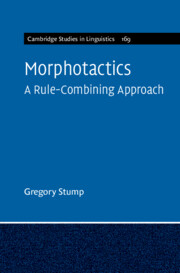Book contents
- Morphotactics
- Cambridge Studies in Linguistics
- Morphotactics
- Copyright page
- Dedication
- Contents
- Figures
- Tables
- Preface and Acknowledgments
- Abbreviations
- Symbols and Operators
- 1 Canonical Morphotactics
- 2 Rule Combinations
- 3 Dependent Rules and Carrier Rules
- 4 Rule Composition and Rule Ordering
- 5 Extending Canonical Morphotactic Criteria to Composite Rules
- 6 Rule Combinations Expressing Holistic Content
- 7 Rule Aggregation
- 8 Complex Morphotactic Interactions in Swahili
- 9 The Nonassociativity of Rule Composition in Murrinhpatha
- 10 Potentiation and Counterpotentiation
- 11 Rule Combinations and Morphological Simplicity
- 12 Rule‑combining Morphotactics and Morphological Theories
- 13 Conclusions
- References
- Index
9 - The Nonassociativity of Rule Composition in Murrinhpatha
Published online by Cambridge University Press: 24 November 2022
- Morphotactics
- Cambridge Studies in Linguistics
- Morphotactics
- Copyright page
- Dedication
- Contents
- Figures
- Tables
- Preface and Acknowledgments
- Abbreviations
- Symbols and Operators
- 1 Canonical Morphotactics
- 2 Rule Combinations
- 3 Dependent Rules and Carrier Rules
- 4 Rule Composition and Rule Ordering
- 5 Extending Canonical Morphotactic Criteria to Composite Rules
- 6 Rule Combinations Expressing Holistic Content
- 7 Rule Aggregation
- 8 Complex Morphotactic Interactions in Swahili
- 9 The Nonassociativity of Rule Composition in Murrinhpatha
- 10 Potentiation and Counterpotentiation
- 11 Rule Combinations and Morphological Simplicity
- 12 Rule‑combining Morphotactics and Morphological Theories
- 13 Conclusions
- References
- Index
Summary
In the rule-combining approach to morphotactics, the same rules may compose in more than one way to express more than one content. Strikingly, Murrinhpatha verb inflection allows the same rules to compose in the same linear order but in different binary groupings to express distinct content. As a consequence of this fact, Murrinhpatha verb forms exhibit a systematic pattern of ambiguity, as illustrated by pubamngankungkardungime (loosely, ‘they saw us’), in which the paucal nonsibling female suffix -ngime may relate to the verb’s object (allowing the interpretation ‘those two siblings saw us (paucal nonsibling females)’) or to its subject (allowing the interpretation ‘they (paucal nonsibling females) saw us two siblings’). As I show, this ambiguity follows from the Category Determination Principle, according to which a rule whose morphosyntactic content is ambiguous is disambiguated by the first rule with which it composes. I give a detailed demonstration that Murrinhpatha verb inflection exploits this fact.
Keywords
- Type
- Chapter
- Information
- MorphotacticsA Rule-Combining Approach, pp. 259 - 297Publisher: Cambridge University PressPrint publication year: 2022

